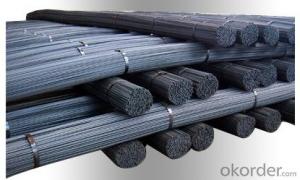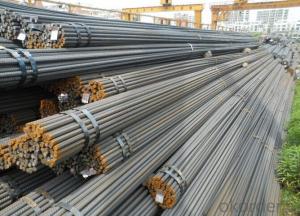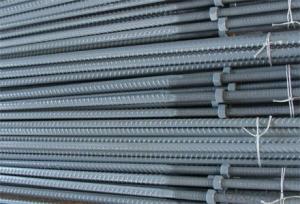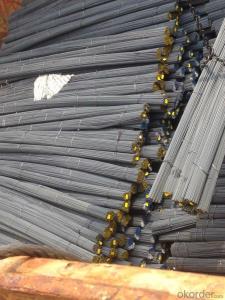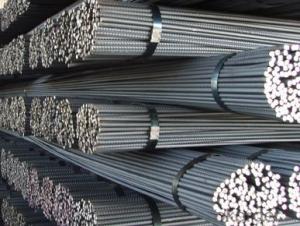GR40 deformed steel bar for construction
- Loading Port:
- Tianjin
- Payment Terms:
- TT OR LC
- Min Order Qty:
- 25 m.t.
- Supply Capability:
- 10000 m.t./month
OKorder Service Pledge
OKorder Financial Service
You Might Also Like
Product Description:
Theoretical weight and section area of each diameter as below for your information:
Diameter(mm) | Section area (mm²) | Mass(kg/m) | Weight of 12m bar(kg) |
6 | 28.27 | 0.222 | 2.664 |
8 | 50.27 | 0.395 | 4.74 |
10 | 78.54 | 0.617 | 7.404 |
12 | 113.1 | 0.888 | 10.656 |
14 | 153.9 | 1.21 | 14.52 |
16 | 201.1 | 1.58 | 18.96 |
18 | 254.5 | 2.00 | 24 |
20 | 314.2 | 2.47 | 29.64 |
22 | 380.1 | 2.98 | 35.76 |
25 | 490.9 | 3.85 | 46.2 |
28 | 615.8 | 4.83 | 57.96 |
32 | 804.2 | 6.31 | 75.72 |
36 | 1018 | 7.99 | 98.88 |
40 | 1257 | 9.87 | 118.44 |
50 | 1964 | 15.42 | 185.04 |
Usage and Applications of Construction
1. Construction steel round bar is mostly used for straight bundles supply, and used for steel, bolts and various mechanical parts. While the bigger round bar, or more than 25mm hot rolled bar, is mainly for the manufacture of mechanical parts or for seamless steel billet.
2. Steel round bar is used in construction and a large number of architectural and engineering structures.
3. Besides, we can supply some especial material steel round bar that can be used for main shaft of steamer, hummer shank, with big section and supper force.
Packaging & Delivery
Packaging Detail: All goods are packed in bundle with steel strips and shipped by break bulk vessel or container (depend on target market and different ports)
Delivery Detail: 45 days
Trade terms: FOB, CFR, CIF
MOQ: 25 tons per specification; we can negotiate the quantity if the specification is normal or we have stock of one specification.
Weight: Theprice invoicing on theoretical weight basis or actual weight basis depends on customer’s request.
Shipment: The shipment of bulk break or container is depends on customer’s request and the situation of the port of destination.
Documents given: Full set of original clean on board bill of lading; Original signed commercial invoice; Original packing list; Policy of insurance; Certificate of origin and what the target market needs.

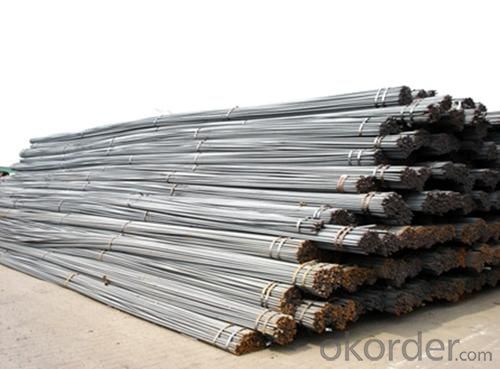
- Q: How do steel rebars help in distributing load in a structure?
- Playing a crucial role in the distribution of load within a structure, steel rebars, also known as reinforcement bars, are of utmost importance. Their primary purpose lies in reinforcing concrete structures, elevating their strength and durability. Strategically positioned within the concrete, rebars effectively counteract any tensile forces that the structure may face. Although concrete possesses strength in compression, it lacks the same strength in tension. Under the application of a load, such as in a building or a bridge, tensile forces arise, causing concrete to crack and eventually fail. By incorporating steel rebars into the concrete, these tensile forces are efficiently disseminated and transferred to the rebars, preventing excessive deflection or collapse of the structure. The inclusion of steel rebars within the concrete creates a composite material, amalgamating the compressive strength of concrete with the superior tensile strength of steel. Consequently, the structure becomes capable of withstanding a wide range of loads, including dead loads (the weight of the structure itself), live loads (such as occupants or furniture), and environmental loads (such as wind or earthquakes). Moreover, rebars serve the purpose of controlling and minimizing the propagation of cracks within the concrete. When a crack forms under load, rebars act as a barrier, impeding the crack's further spread and safeguarding the structure's integrity. This hinders the development of larger cracks that could potentially lead to structural failure. Furthermore, steel rebars provide stability and reinforcement at critical points within the structure, such as corners, joints, and areas prone to high stress. By reinforcing these vulnerable areas, rebars ensure that the load is evenly distributed throughout the structure, reducing the risk of localized failures. In conclusion, steel rebars are indispensable in distributing load within a structure by absorbing tensile forces, strengthening concrete, preventing crack propagation, and reinforcing critical locations. They significantly contribute to the overall structural integrity and safety, solidifying their vital role in construction projects.
- Q: What is the ductility of steel rebars?
- The ductility of steel rebars refers to its ability to deform under tension without fracturing. Steel rebars are known for their high ductility, allowing them to withstand significant bending and stretching without breaking. This property makes them ideal for reinforcing concrete structures, where they can absorb and distribute loads effectively.
- Q: The difference between rebar and crescent
- Rebar -- steel used in concrete structures with a generally rounded cross section and ribbed surface.Longitudinal ribs -- uniform continuous ribs parallel to the axis of the steel bar -- other ribs not parallel to the axis of the reinforcement.The longitudinal section of crescent ribbed bars -- transverse rib reinforced crescent, and does not intersect with longitudinal ribs.
- Q: Can steel rebars be used in structures with high levels of chloride or sulfate attack?
- No, steel rebars should not be used in structures with high levels of chloride or sulfate attack as these chemicals can cause corrosion and deterioration of the steel, compromising the structure's integrity.
- Q: How are steel rebars identified based on their grades?
- Steel rebars are identified based on their grades through markings or labels on the surface of the rebars. These markings typically indicate the grade of the steel rebars, which is determined by the strength and composition of the steel.
- Q: Can steel rebars be used in wastewater treatment plant construction?
- Certainly, steel rebars are applicable for the construction of wastewater treatment plants. They are frequently utilized in the development of reinforced concrete structures, specifically in the context of wastewater treatment facilities. These rebars contribute to the concrete's enhanced strength and durability, enabling it to endure the harsh and corrosive conditions commonly encountered in such facilities. To shield the rebars from the corrosive impact of wastewater, they are typically coated with epoxy or other corrosion-resistant substances. Furthermore, the proper design and positioning of the rebars guarantee the structural soundness and longevity of the treatment plant. In conclusion, steel rebars serve as a widely employed and effective reinforcement material in wastewater treatment plant construction.
- Q: Can steel rebars be used in retrofitted structures?
- Yes, steel rebars can be used in retrofitted structures. In fact, they are commonly used in retrofitting projects to enhance the structural integrity and strength of existing buildings or structures. Steel rebars can be added to reinforce and strengthen critical areas, such as columns, beams, and foundations, improving their ability to resist additional loads or seismic forces.
- Q: Can steel rebars be used in underwater structures?
- Yes, steel rebars can be used in underwater structures. Steel rebars are commonly used in construction projects to reinforce concrete structures and provide additional strength and stability. When it comes to underwater structures, such as bridges, dams, and offshore platforms, the use of steel rebars is crucial due to their excellent strength and durability. However, the use of steel rebars in underwater structures requires additional considerations. One of the main concerns is corrosion, as exposure to water and salt can accelerate the corrosion process. To mitigate this issue, corrosion-resistant steel rebars, such as stainless steel or epoxy-coated rebars, are used. These rebars have protective layers that prevent direct contact between the steel and water, minimizing the risk of corrosion. Furthermore, proper design and construction techniques are essential when using steel rebars in underwater structures. Adequate concrete cover and proper spacing between rebars are crucial to ensure sufficient protection against corrosion and maintain the structural integrity of the underwater structure. Additionally, regular inspection and maintenance are necessary to identify and address any signs of corrosion or deterioration in the rebars. In conclusion, steel rebars can be used in underwater structures, but it requires careful consideration of corrosion protection measures and adherence to proper design and construction practices. With the right precautions in place, steel rebars can provide the necessary strength and durability for underwater structures.
- Q: Can steel rebars be used in structures with limited foundation support?
- Yes, steel rebars can be used in structures with limited foundation support. Steel rebars are commonly used as reinforcement in concrete structures to enhance their strength and durability. In structures with limited foundation support, the steel rebars can help distribute the load more evenly throughout the structure, minimizing the stress on the foundation. Additionally, the use of steel rebars can also increase the overall stability of the structure. However, it is important to note that the design and placement of the rebars should be done by a qualified engineer to ensure that they are properly integrated into the structure and can effectively bear the load.
- Q: What are the guidelines for installing steel rebars in concrete columns?
- The guidelines for installing steel rebars in concrete columns typically include ensuring the proper spacing and alignment of the rebars, using appropriate reinforcement sizes and types, securely tying the rebars at intersections, providing sufficient cover for the rebars, and ensuring proper anchorage and lap length for effective structural integrity. It is also important to follow any specific regulations or requirements outlined by local building codes or project specifications.
Send your message to us
GR40 deformed steel bar for construction
- Loading Port:
- Tianjin
- Payment Terms:
- TT OR LC
- Min Order Qty:
- 25 m.t.
- Supply Capability:
- 10000 m.t./month
OKorder Service Pledge
OKorder Financial Service
Similar products
Hot products
Hot Searches
Related keywords
